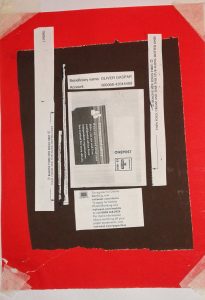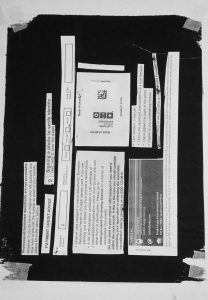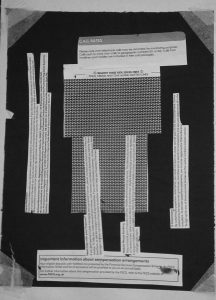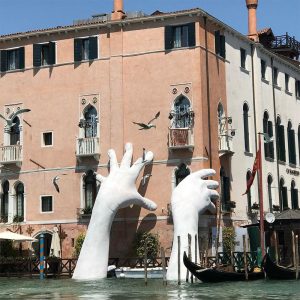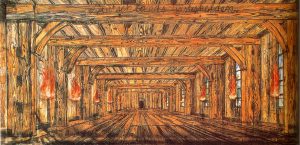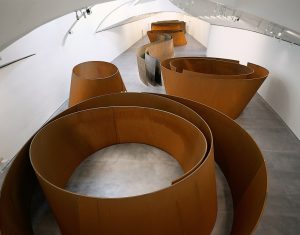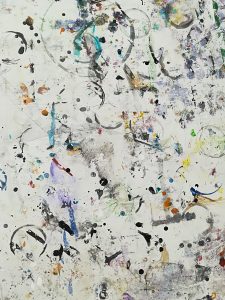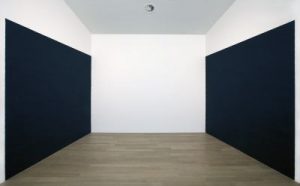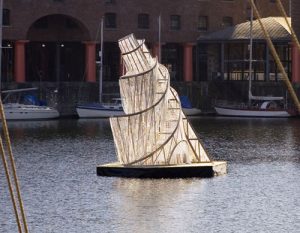
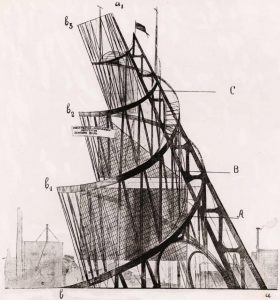
Ai Weiwei, Fountain of Light, 2007 Tatlin’s construcivist tower design, 1919
The original tower was designed by Vladimir Tatlin in 1919 as a celebration of the formation of the Communist Third International after the Bolshevik Revolution of 1917. Designed as part of the Constructivist movement it was supposed to be made from steel, iron and glass. These components were significant as they were symbolic of power, hope and modernity. It was going to be over 400m high, taller than the Eiffel tower, but never actually got constructed due to a lack of materials. Ai Weiwei transformed Tatlin’s monumental constructivist design into an 8 meter tall chandelier. Lit with 800 lightbulbs, it was shown at the Tate Liverpool, floating in the Albert Dock. It was a site specific work, designed specifically for Liverpool. This was particularly relevant due to Tatlin’s tower’s links with industrialisation which played such a big part in shaping modern Europe, especially Liverpool.
Their manifesto states that a constructivist object is ‘simply a product of an industrial order like a car, an aeroplane and such like.’ The fact it has been turned into this decorative chandelier made of crystal completely undermines the original constructivist ideals of powerful, strong utopian design. However I don’t think that Ai Weiwei is mocking Tatlin’s ideals by transforming his tower into a chandelier. Ai’s tower can definitely be seen as a tribute to Tatlin’s tower which was never realised.
The National. (2017). Louvre Abu Dhabi: the long-awaited first look inside. [online] Available at: https://www.thenational.ae/arts-culture/louvre-abu-dhabi-the-long-awaited-first-look-inside-1.673668 [Accessed 7 Dec. 2017].
Royalacademy.org.uk. (2017). Ai Weiwei: 13 works to know | Blog | Royal Academy of Arts. [online] Available at: https://www.royalacademy.org.uk/article/ai-weiwei-13-works-to-know [Accessed 7 Dec. 2017].
Tate.org.uk. (2017). Cite a Website – Cite This For Me. [online] Available at: http://www.tate.org.uk/download/file/fid/6611 [Accessed 7 Dec. 2017].
Ft.com. (2017). Auditions for the role of China’s Picasso. [online] Available at: https://www.ft.com/content/b31bc7f6-e910-11db-a162-000b5df10621 [Accessed 7 Dec. 2017].
www.wikiart.org. (2017). Monument to the Third International, 1919 – 1920 – Vladimir Tatlin. [online] Available at: https://www.wikiart.org/en/vladimir-tatlin/monument-to-the-third-international-1920 [Accessed 7 Dec. 2017].
Mundy, J. (2017). Lost Art: Vladimir Tatlin. [online] Tate.org.uk. Available at: http://www.tate.org.uk/context-comment/articles/lost-art-vladimir-tatlin [Accessed 7 Dec. 2017].
The Art Story. (2017). Constructivism Movement, Artists and Major Works. [online] Available at: http://www.theartstory.org/movement-constructivism-artworks.htm [Accessed 7 Dec. 2017].
Anneberk.nl. (2017). Ai Weiwei – Anne Berk. [online] Available at: http://anneberk.nl/articles-english/ai-weiwei/ [Accessed 7 Dec. 2017].
Tate. (2017). The Real Thing: Ai Weiwei: born 1957 | Tate. [online] Available at: http://www.tate.org.uk/whats-on/tate-liverpool/exhibition/real-thing-contemporary-art-china/real-thing-exhibition-guide-11 [Accessed 7 Dec. 2017].
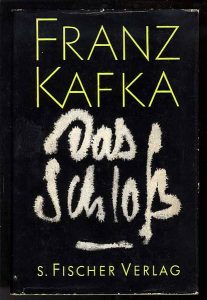 My chosen book to summarize is the novel “The Castle” from Franz Kafka. It is not a book I chose from the library but a book I had. I chose this because it’s closely related to one of my recent works and it’s the only book lately I could read from it’s beginning to the end.
My chosen book to summarize is the novel “The Castle” from Franz Kafka. It is not a book I chose from the library but a book I had. I chose this because it’s closely related to one of my recent works and it’s the only book lately I could read from it’s beginning to the end.

